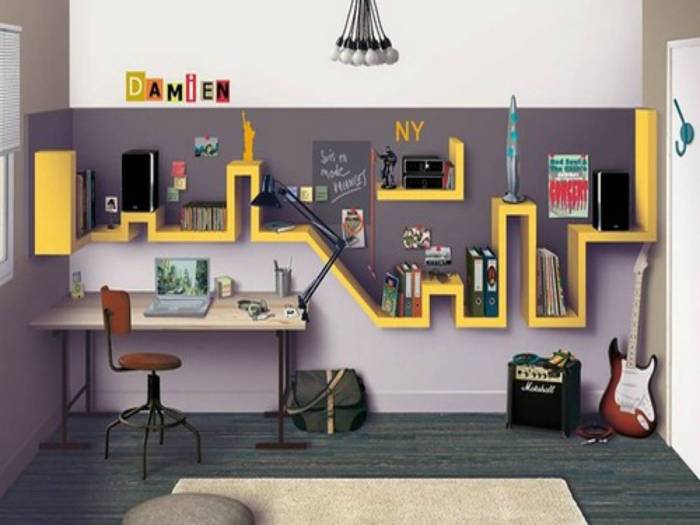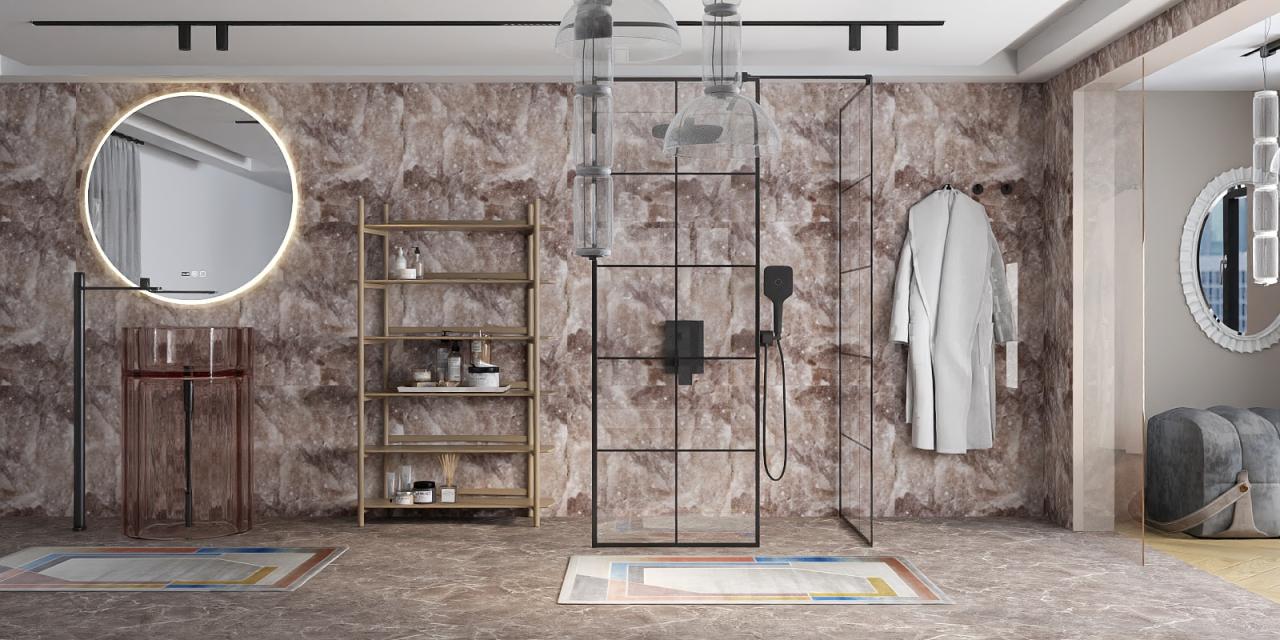Unleash Your Creativity: 50 Interior Design Ideas explores a wealth of transformative concepts for enhancing your living spaces. From modern minimalist living rooms to vibrant children’s bedrooms, this guide delves into diverse design styles, innovative material choices, and creative techniques to inspire your next home project. We’ll examine how color psychology, biophilic design, and sustainable materials can contribute to creating functional and aesthetically pleasing environments.
This comprehensive guide offers practical advice and visually engaging examples, empowering you to transform your home into a reflection of your personal style and preferences. Whether you’re a seasoned DIY enthusiast or a design novice, you’ll find inspiration and actionable steps to bring your creative vision to life. The guide covers room-by-room transformations, explores various design styles and themes, and provides innovative ideas for material choices and creative techniques, ensuring a holistic approach to interior design.
Room-by-Room Design Transformations

Transforming your home into a space that reflects your personality and lifestyle can be an exciting journey. This section explores the design possibilities for several key rooms, offering practical ideas and inspiration for your own home renovation projects. We will focus on creating functional and aesthetically pleasing spaces tailored to their specific purpose.
Living Room Design Layouts
Three distinct living room layouts will be presented, each showcasing a different design style: modern minimalist, bohemian, and traditional. These examples demonstrate the versatility of interior design and how different aesthetics can create unique atmospheres.
| Style | Color Palette | Furniture | Key Features |
|---|---|---|---|
| Modern Minimalist | Neutral tones (white, gray, beige) with pops of black or a single bold accent color. | Clean-lined sofa, low profile coffee table, minimalist shelving, possibly a single statement chair. | Emphasis on simplicity, functionality, and clean lines. Minimal clutter, open space, and natural light are prioritized. |
| Bohemian | Earthy tones (terracotta, olive green, mustard yellow) combined with rich jewel tones and metallic accents. | Comfortable, eclectic mix of furniture, including a plush sofa, oversized armchairs, low seating options, and a variety of textures (e.g., woven rugs, sheepskin throws). | Layering of textures, patterns, and colors. Incorporates global influences and handcrafted items. Creates a relaxed and inviting atmosphere. |
| Traditional | Classic color schemes (navy blue, cream, beige, muted greens) with rich wood tones. | Formal seating arrangement, including a large sofa, armchairs, and possibly a chaise lounge. Features ornate details and high-quality materials. | Emphasis on symmetry, balance, and classic design elements. Incorporates traditional furniture styles and decorative accessories. Creates a sophisticated and elegant atmosphere. |
Master Bedroom Makeover: Maximizing Space and Calming Elements
A master bedroom should be a sanctuary, a space for relaxation and rejuvenation. This makeover focuses on maximizing space and incorporating calming elements to create a serene retreat. Effective space planning and the strategic selection of furniture and decor are key to achieving this.
The following essential furniture and decor items are recommended for a calming and spacious master bedroom:
- A platform bed with built-in storage to maximize floor space and minimize visual clutter.
- Nightstands with drawers for storing personal items.
- A large, well-lit mirror to create the illusion of more space and enhance the room’s brightness.
- Calming wall colors such as soft blues, greens, or grays.
- Soft, natural textiles such as linen or cotton for bedding and curtains.
- A comfortable seating area with a chaise lounge or armchair for reading or relaxing.
- Minimalist artwork or a calming nature scene to add a touch of personality without overwhelming the space.
Functional and Stylish Home Office Design
A well-designed home office promotes productivity and well-being. This plan incorporates organizational solutions and ergonomic considerations to create a functional and stylish workspace.
Here is a bulleted list outlining key elements for a productive and comfortable home office:
- An ergonomic desk chair that provides proper lumbar support and adjustability.
- A desk with ample workspace and storage, potentially incorporating built-in drawers or shelving.
- Efficient storage solutions such as filing cabinets, shelves, and drawer organizers to keep documents and supplies neatly organized.
- Adequate lighting, including both overhead and task lighting to reduce eye strain.
- A comfortable and supportive keyboard and mouse to prevent repetitive strain injuries.
- A monitor stand to position the screen at eye level.
- Plants to add a touch of nature and improve air quality.
Vibrant and Playful Children’s Bedroom Design
Designing a child’s bedroom requires careful consideration of age-appropriateness and safety. This design prioritizes a vibrant and playful atmosphere while ensuring a safe and functional space.
The color scheme should be bright and cheerful, perhaps using a combination of pastel shades with a few bold accent colors. Furniture should be age-appropriate, sturdy, and easy to clean. Storage solutions are crucial to maintain organization and prevent clutter. Rounded furniture edges and non-toxic materials should be prioritized for safety. A playful theme, perhaps based on the child’s interests, can add personality and make the space more engaging.
Exploring Diverse Design Styles and Themes

Interior design offers a vast landscape of styles and themes, each capable of transforming a space into a unique reflection of personal taste and lifestyle. Understanding the nuances of different design approaches allows for informed choices that create functional and aesthetically pleasing environments. This section delves into the characteristics of several popular styles, the power of biophilic design, the psychology of color, and the captivating allure of culturally-inspired interiors.
Comparison of Interior Design Styles
A comparative analysis of three distinct interior design styles – Mid-Century Modern, Farmhouse, and Industrial – reveals their unique approaches to aesthetics and functionality. Understanding these differences allows for informed selection based on individual preferences and the overall desired ambiance.
| Style | Defining Characteristics | Color Palette | Materials |
|---|---|---|---|
| Mid-Century Modern | Clean lines, simple forms, functionality, organic shapes, tapered legs on furniture. | Muted earth tones, yellows, oranges, greens, browns, occasional pops of bolder colors. | Wood (teak, walnut), metal (brass, chrome), leather, upholstery fabrics. |
| Farmhouse | Rustic charm, vintage accents, natural materials, comfortable and cozy atmosphere, exposed beams. | Whites, creams, grays, muted blues, greens, browns, with pops of bolder colors for accents. | Wood (distressed or reclaimed), stone, metal (blacksmith finishes), linen, cotton fabrics. |
| Industrial | Exposed brick, metal piping, concrete floors, raw and unfinished aesthetics, minimalist approach. | Neutral tones (grays, blacks, whites), metallic accents (copper, bronze), occasional pops of color. | Metal (steel, iron, copper), concrete, wood (reclaimed or distressed), exposed brick. |
Biophilic Design with Natural Elements
Biophilic design incorporates natural elements to foster a connection between the indoors and the outdoors, promoting well-being and a sense of calm. The strategic use of wood, stone, and plants creates spaces that are visually appealing and psychologically restorative.
Wood can be used in flooring, furniture, and wall paneling. Stone can be incorporated into countertops, fireplaces, or accent walls. Plants, in various sizes and types, can be placed throughout the room to add life and vibrancy. For instance, a living room might feature a wooden coffee table, a stone fireplace surround, and several potted plants strategically placed to add visual interest. A bedroom might use wooden flooring and a headboard made of reclaimed wood, with smaller plants on the nightstands.
Color Psychology and Mood Evocation
Color psychology plays a significant role in shaping the mood and atmosphere of a space. Different colors evoke different emotional responses, and understanding these relationships allows designers to create spaces that promote specific feelings.
Calming blues and greens are often used in bedrooms to create a tranquil and restful environment. A calming bedroom palette might include soft blues, gentle greens, and creamy whites. Energizing yellows and oranges are frequently found in kitchens and dining areas to stimulate appetite and encourage social interaction. An energizing kitchen palette could include sunny yellows, warm oranges, and vibrant reds as accents.
Japanese Minimalist Interior Design Project
This project focuses on creating a serene and minimalist Japanese-inspired living space. The color scheme emphasizes natural tones – soft grays, creams, and natural wood tones. Furniture is kept to a minimum, featuring low-profile pieces with clean lines, such as a tatami mat floor, a low coffee table made of light wood, and simple, unadorned chairs. Decorative elements are sparse, focusing on natural materials like bamboo and stone, and possibly incorporating a few carefully selected pieces of Japanese art or calligraphy. The overall effect is one of calm, order, and tranquility, reflecting the core principles of Japanese minimalism.
Innovative Material Choices and Creative Techniques

Exploring innovative materials and techniques is key to unlocking truly unique and sustainable interior design solutions. By thoughtfully selecting materials and employing creative approaches, we can elevate the aesthetic appeal and functionality of any space while minimizing environmental impact. This section delves into specific examples showcasing the potential of sustainable materials and repurposed items, alongside effective lighting strategies and a DIY project guide.
Sustainable Kitchen Design
Creating a kitchen that is both stylish and environmentally conscious is achievable through the careful selection of materials. The following materials offer both aesthetic appeal and environmental benefits, contributing to a healthier and more sustainable living space.
- Bamboo countertops: These offer a durable, renewable alternative to traditional stone or wood. Benefits include: high strength-to-weight ratio, resistance to water damage, and a naturally beautiful aesthetic. The visual impact is a warm, slightly textured surface, often with subtle variations in color.
- Reclaimed wood cabinets: Using reclaimed wood reduces deforestation and offers unique character and charm. Benefits include: a rich, varied patina, reduced environmental impact, and a rustic or industrial aesthetic depending on the wood’s finish. Imagine rich, dark tones with visible grain patterns, offering a sense of history and authenticity.
- Recycled glass backsplash: Recycled glass tiles create a vibrant and sustainable backsplash. Benefits include: durability, easy cleaning, and a visually striking, modern aesthetic. Picture a shimmering backsplash with a blend of colors and textures, reflecting light beautifully.
- Cork flooring: Cork is a sustainable and naturally insulating material. Benefits include: comfort underfoot, sound absorption, and a warm, natural aesthetic. The visual impact is a warm, soft surface with a subtle, natural grain.
- Linoleum flooring: A surprisingly sustainable and durable option, especially when made with natural materials and recycled content. Benefits include: water resistance, ease of cleaning, and a variety of colors and patterns. It can range from a classic, simple look to bold, modern designs.
Repurposed Materials in Interior Design
Repurposing and recycling materials offers a unique opportunity to create one-of-a-kind design elements while promoting sustainability. The following examples demonstrate the transformative potential of discarded items.
- Old window frames as wall art: Stripped down and repainted, old window frames can create a rustic-chic wall feature. Imagine several frames arranged in a visually appealing pattern, perhaps showcasing family photos or pressed flowers within the panes.
- Wine crates as shelving units: Stacked and secured, wine crates form a charming and rustic shelving system, perfect for a pantry or a living room display. Visualize a staggered arrangement, stained a rich dark brown, holding books, plants, or decorative items.
- Pallet wood as a headboard: Disassembled and sanded, pallet wood can be reassembled into a unique and stylish headboard. Picture a rustic headboard, painted white or left natural, providing a focal point for a bedroom.
- Tin cans as pendant lights: Cleaned, painted, and wired, tin cans transform into quirky and charming pendant lights. Imagine a grouping of various sized cans, each painted a different bright color, hanging at different heights above a kitchen island.
- Old suitcases as coffee tables: Vintage suitcases, stacked and secured, can create a unique and conversation-starting coffee table. Visualize two or three vintage suitcases, each with a different pattern and color, stacked to create a low, sturdy table.
Dining Room Lighting Design
Effective lighting is crucial for creating the desired ambiance and functionality in a dining room. A layered approach, combining ambient, task, and accent lighting, is recommended.
Ambient lighting provides overall illumination. A central chandelier or a flush-mount fixture can serve this purpose. Task lighting, such as recessed lighting above the dining table, ensures adequate illumination for dining. Accent lighting, such as wall sconces or picture lights, highlights architectural details or artwork, adding depth and visual interest. The placement of these fixtures is key: the chandelier should be centered above the table, recessed lights should be evenly spaced, and sconces should be placed strategically to highlight specific features.
DIY Feature Wall Creation
Creating a feature wall using unconventional materials is a relatively simple yet impactful DIY project. The following steps Artikel the process of creating a reclaimed wood feature wall.
- Preparation: Clean and prepare the wall surface. Ensure it is smooth, free of any debris, and primed for optimal adhesion. Visualize a clean, even surface, ready for the installation process.
- Material Selection: Choose reclaimed wood planks of varying lengths and widths for a rustic and textured look. Consider the color and grain pattern for visual appeal. Imagine a variety of wood tones and textures, creating a visually interesting and unique wall.
- Installation: Using construction adhesive and nails, secure the wood planks to the wall. Leave small gaps between the planks for a more natural look. Visualize the wood planks being carefully placed and secured, creating a visually appealing pattern on the wall.
- Finishing: Once the wood is secured, apply a sealant or stain to protect the wood and enhance its color. Visualize the wood planks taking on a rich, protective finish, enhancing their natural beauty.
- Finishing Touches: Add any final touches, such as additional décor or lighting to complement the feature wall. Visualize the finished feature wall, a stunning centerpiece in the room, complemented by carefully chosen accessories.
Closure

Transforming your home shouldn’t be daunting; it should be an exciting journey of self-expression. “Unleash Your Creativity: 50 Interior Design Ideas” provides the roadmap and inspiration you need to navigate this process with confidence. By exploring diverse design styles, incorporating sustainable practices, and employing creative techniques, you can create a space that is not only beautiful but also reflects your unique personality and enhances your overall well-being. Start envisioning your dream home today!